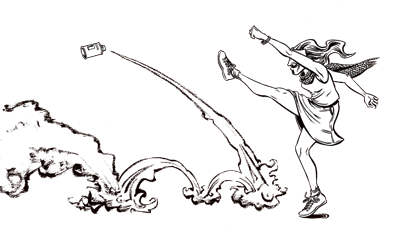The Kuleshov Effect is a phenomenon in cinema whereby audiences perceive facial expressions differently depending on context. In the 1910’s and 20’s, Russian filmmaker Lev Kuleshov designed an experiment that involved a sort of movie collage: A shot of a bowl of soup, followed by the impassive face of handsome actor Ivan Mozzhukin reacting to it; then a shot of a little child in a coffin, followed by Mozzhukin’s face again; finally a shot of a beautiful and seductively dressed woman, and Mozzhukin’s reaction. Audiences praised Mozzhukin’s brilliantly subtle acting, his nuanced expression of hunger, restrained grief, and boiling lust. But as you probably have predicted already, each reaction shot was exactly the same – the same footage every time.
Alfred Hitchcock explains the same phenomenon in this video:
HOW DOES THIS APPLY TO COMICS?
On the one hand, comics artists, and cartoonists in particular, have an obsession with, almost a fetishization of, facial expressions. From the simplest distillation of an emotion into a few carefully-chosen lines, to an elaborately rendered portrait of a distinct countenance, we all seem to strive for the most evocative faces possible. Some people have actually insisted this is the single most important storytelling mechanism for a comics artist, more important even than body language. The ridiculously great facial-expression guide by Lackadaisy artist and comics samurai Tracy Butler has been making the rounds on the internet, and deservedly so. She’s got the art of drawing facial expressions down to a science (or maybe the science down to an art – I’m not sure.)
But on the other hand, comics are not single images like a painting, but an arranged series, like a movie. Because we tell our stories through sequential juxtaposition, *ahem, puts on green plaid shirt and opaque full-moon glasses*, why exactly do we need the perfect, nuanced facial expression every time, when, at least according to the theory of the Kuleshov effect, a perfectly neutral face will do? An incredible amount of emotion can be imparted into a blank face given the context that comics can provide. Sarah Oleksyk took this to its sublime extreme in one of my favorite single comics panels of all time, from book five of her series Ivy:
Here, perhaps the biggest emotional turning point of the entire series is represented a 3/4-rear shot. What is Ivy thinking? Oleksyk doesn’t say. She only asks what YOU think she’s thinking.
Two years ago, when I started this comic you’re reading now, I had not heard the term “Kuleshov Effect,” but I knew I was interested in the comics possibilities of blank, ambiguous facial expressions, and I used them a lot. This was particularly useful since I was still learning how to draw.
I’ve come a long way in my artistic abilities since then, and I like to think I’m capable of much more convincing, expressive faces that are interesting in themselves. But sometimes I worry that I’ve thrown out baby Kuleshov with the bathwater. I try to remember that sometimes, rather than telegraphing emotion so obviously, the right thing to do is to let the reader fill in their own subtext.







